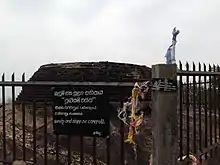Kuragala
Kuragala (Sinhala: කූරගල) is a pre-historic archaeological site with ruins of ancient Buddhist Cave temple complex, dating back to the 2nd century BC, in Balangoda, Sri Lanka. The temple complex is located on the Balangoda - Kaltota road (B38) approximately 24 km (15 mi) distance from the Balangoda town. The site has been formally recognised by the Government as an archaeological reserve in Sri Lanka. Kuragala is considered as the oldest archaeological site found in the Intermediate Zone.[1]
| Kuragala Ancient Buddhist Monastery | |
|---|---|
කූරගල පුරාණ බෞද්ධ ආරාම සංකීර්ණය | |
 A view of Akasha Chaitya at Kuragala | |
| Religion | |
| Affiliation | Buddhism |
| District | Ratnapura |
| Province | Sabaragamuwa Province |
| Location | |
| Location | Balangoda |
| Country | Sri Lanka |
| Geographic coordinates | 06°37′44.4″N 80°51′51.9″E |
| Architecture | |
| Type | Buddhist Temple |
| Style | Cave temple |
| Completed | circa 20 century AD |
History
Pre-historic evidences
According to the archaeological evidences found, Kuragala area had been used by humans belonging to the pre-historic period.[2] From the excavations, archaeologists found stone tools, fossilized bone fragments and remains of a human skeleton which is believed to be aged more than 8,000 years.[3][4] Investigations further revealed that the humans lived in Kuragala may had close links with the coastal areas as it found the remnants of seashells and shells of clams.[3] Recent studies done in the Kuragala Kaltota Diyawinna area have revealed that beside the hunting, they had also engaged in agricultural activities as well.[5]
Buddhist monastery

The extensive investigations, carried out by the archaeological department at the Kuragala, uncovered evidences that the caves at the site were using as a Buddhist monastery during the period between 3rd century BC and first century AD.[3][7] An archaeological report on Kuragala area, published by C.H. Collins in 1932, documents about the two cave shelters and 2nd century BC Brahmi inscriptions as well as about the carved stone lintels, stairways and platforms, located at the foot of the Kuragala brae (Budugala area). From eye copies, C. H Collins published his interpretations of Kuragala inscriptions in JRASCB, XXXII, 1932. These inscriptions were reread, and republished in Inscriptions of Ceylon Vol. I by the archaeological department.[8]
Researches done by Sri Lankan archaeologists and epigraphers have established that, inscribed cave shelters were made for Buddhist monks by donors as religious donations.[9] Caves provide shelter to them during the annual rainy season retreat as prescribed in Theravada Buddhist tradition. Existence of dripledged caves in a site indicate that they were inhabited by Bhikkhus during the past period and epigraphs further reveal the names of donors who donate the prepared caves to them.
At the summit of the Kuragala is a brick built Stupa which is now an archaeologically protected monument. The Stupa is considered belongs to the tradition of Akasa Chaithya which type of Stupa were built since 7th century CE to serve as communication beacons giving directions.[10]
Muslim shrine
According to the book written by Jailani Mosque it is claimed that there are several writings in Arabic and the direction of the Kaaba (kibla) is shown in the form of a mihrab cut into the rock and a tombstone with the words “Darvesh Mohiyadin Darvesh”, and the remains found when excavating to build the mosque, was laid to rest on the southern side of the mosque with the date Hijri 715. It claims Hituwangala to be “Kai Adi Malai” (Palm print rock) as the Saint is said to have placed his palm print in sandalwood paste.[11] However all structures were built in the 20th century with no archeological evidence to support the claim. [12]
In 2013 after the Mosque attempted to expand into the caves and began covering up inscriptions with cement and destroying others with concentrated acid the archeological department intervened and demolished most of the illegal constructions but the mosque remains. [13]
References
- "Kuragala recognised the oldest archaeological site in Intermediate Zone". The Island (Sri Lanka). Upali Newspapers. 20 May 2014. Retrieved 24 September 2017.
- "PM promises to conserve Kuragala site without allowing it to become communal issue". The Island (Sri Lanka). Upali Newspapers. 22 October 2015. Retrieved 24 September 2017.
- "'Don't create religious issues based on Kuragala' - DG of Archaeology". The Official Government News Portal of Sri Lanka. Retrieved 24 September 2017.
- "Govt. to conduct archaeological fact-finding mission in Kuragala". Daily FT. Wijeya Newspapers. 23 October 2015. Retrieved 24 September 2017.
- "Startling new evidence on pre-historic man found in Kuragala (Video)". News First. 10 April 2014. Retrieved 24 September 2017.
- JRASCB XXXII:167; ASCAR 1961-62:82; Paranavitana 1970:774-776
- "Kuragala Controversy Deepens". The Sunday Leader. Leader Publications. 31 May 2015. Retrieved 24 September 2017.
- "What Paranavitana said to McGilvray: 'Do your homework son'". The Nation (Sri Lanka). Rivira Media Corporation (Pvt) Ltd. 4 August 2013. Retrieved 24 September 2017.
- McGilvray, Dennis B. (2016). Islam, Sufism and Everyday Politics of Belonging in South Asia (edited by Deepra Dandekar and Torsten Tschacher). Taylor & Francis. p. 67. ISBN 9781317435969.
However, research by Sri Lankan archaeologists and epigraphers establishes that such inscribed caveshelters were intended by their donors as religious gifts to support the monkhood in Sri Lanka, providing shelter during the annual rainy season (vassa) retreat as prescribed in Theravada Buddhist tradition (Paranavitana 1970; Dias 2001: 14–18)
- ""I had no intention of resolving any conflict at Kuragala" Prof. Raj Somadeva says". The Nation (Sri Lanka). Rivira Media Corporation (Pvt) Ltd. 6 June 2015. Retrieved 25 September 2017.
- Dafther Jailany, M.L.M. Aboosally, 2002
- "Kuragala: Buddhist Sacred Site Or Sufi Shrine?". Retrieved 15 May 2020.
- "https://amazinglanka.com/wp/kuragala/". Retrieved 2019-08-15. External link in
|title=(help)